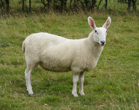
Following the development of the Leicester Longwood by Robert Bakewell in Leicestershire, George & Mathew Culley, students of Bakewell, settled in the Glendale district of Northumberland with some of Bakewells flock around 1767.
Two distinct types of ‘Leicester" evolved in the Borders. The Culley brothers crossed with the local Teeswater breed, but other farmers in the region were crossing in some Cheviot blood. This led to the two variations nicknamed the "Bluecaps" and the "Redlegs". The Border farmers preferred the hardier redlegs and by about 1850 this variation became known as the "BORDER LEICESTER"
This alert-looking longwool breed is distinguished by a strongly-convex “Roman” nose and large, upright ears on a wool-free head emerging from a thick fleece composed of long, curled “pencil” locks. These long-backed sheep have a blocky profile thanks to their ample fleeces. Head and legs are free of wool.
The value of the Border Leicester lies in its capacity for profitable alliance with other breeds.
The value of the Border Leicester lies in its capacity for profitable alliance with other breeds. Amongst sheep, the Border Leicester is the breed whose value has been pre-eminently that of an improver of others, the rams can even be safely be used on the smallest ewes, indeed one of the smallest, the Welsh Mountain, is used to produce the Welsh Half-bred.
Rams give high levels of vigour to offspring from all types of dam, leading to rapid growth, good carcase conformation, milkiness & hardiness. Ewes are prolific, excellent mothers, and being good foragers. The crossbred progeny show a strong uniformity - an important factor in selling to both butchers and as breeding stock.

Border Leicester showing alert head
Border Leicester dual purpose breed
Gregarious nature






